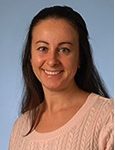04-08-2021
Recent Research with KTB samples

The following describes and explains (KTB lab scientist) Dr. Natascia Marino’s most recently published article, Upregulation of lipid metabolism genes in the breast prior to cancer diagnosis; Marino, et. al, 2020.
For years, researchers have been looking for signs of changes in the breast that may lead to the formation of cancer cells as keys to earliest diagnosis and prevention. They want to pinpoint changes that, ultimately, they could halt or change to prevent cancer from forming. For most studies, they have examined “normal adjacent tissue (NAT),” or tissue surrounding cancer cells that already have formed. They know that NAT is genetically altered when cancer rises in nearby tissue, and that NAT tissue is affected at the genetic and cellular levels.
Therefore, using NAT as a “normal control” for studies may not allow a full understanding of how cancer develops in previously unaffected breast tissue. The Komen Tissue Bank has been collecting healthy breast tissue from donors for 13 years, amassing samples from 5,500 tissue donors, and has tracked the women after donation to see if any develop breast cancer. In this study, the first of its kind, researchers used KTB samples to examine alterations in breast tissue donated by women prior to a cancer diagnosis, before any cancer cells had formed or were detectible. With these samples, they could explore what changes already were underway months or years before diagnosis.
Methods
As expected, some women who donated their healthy breast tissue later were diagnosed with breast cancer. Researchers used samples from two donors who had donated to the Komen Tissue Bank prior to the discovery of their breast cancer: researchers analyzed the tissue originally donated before their cancer diagnoses (subsequently referred to as “susceptible normal tissue”); the normal adjacent tissue after their tumors formed; and tissue from their non-diseased (contralateral) breasts collected after diagnosis.
The scientists compared several processes to find the earliest changes that took place before a diagnosis. Both susceptible normal tissue and NAT displayed molecular differences compared to the contralateral breast tissue, which suggest early activation of specific pathways in cellular and metabolic processes before cancer develops.
They then looked at samples of susceptible tissue from seven women and 15 healthy controls to separately profile the three breast tissue compartments: epithelium, stroma and adipose tissues. This allowed them to examine metabolic “rewiring,” an expression of genes in involved in lipid metabolism and adipogenesis (the formation of fat cells). This rewiring is one of the first features of breast tissue affected by tumorigenesis (the rise of cancer cells). They also looked at how immune cells reacted to these processes and other subtle changes.
Findings
The study found the tissue collected before the formation of tumor cells (susceptible normal tissue) is more similar to tissue found near breast cancer tumor cells (normal adjacent tissue) than that of the unaffected breast tissue of the same donor. So even before the cancer formed, this susceptible tissue had more in common with tissue found near cancer cells than with unaffected breast tissue.
The research pointed to several markers that might be used to identify the origins of cancer, including an increase in lipid metabolism genes found in susceptible normal tissue compared to breast tissue of healthy women. Healthy cells take in fatty acids naturally, but cancer cells synthesize fatty acids in a different way that makes breast tissue susceptible to the development of cancer.
The study identified molecular alterations linked to this processing of fat in breast tissue of women two to six years before they had a diagnosis of breast cancer. Some of these processes also interfere with the body’s anti-cancer immune responses. These and other components of the affected breast tissue work to create an environment favorable for cancer growth years before detection is possible.
Why this study is important
The unique resources of the Komen Tissue Bank allowed researchers to look at normal breast tissue years before cancer cells developed. Previously, scientists had used normal adjacent tissue in patients already diagnosed with breast cancer. In this study, using susceptible tissue, they tracked changes in breast tissue that led to the formation of cancer cells. This may give scientists new targets for interrupting changes in the tissue that lead to breast cancer. They view this data as insights to future methods of screening and prevention.
Much remains to be accomplished, researchers say, such as studying how these changes in susceptible breast tissue may affect the formation of different types of breast cancer as well has how they affect women of different demographic and higher risk groups.




